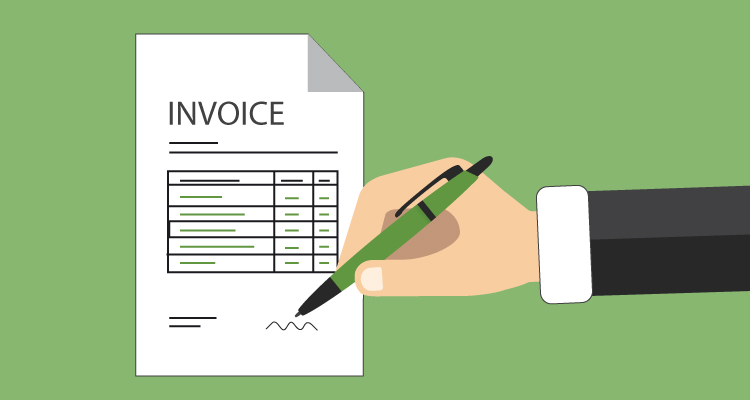No matter how long you’ve been in business, or how much of an invoice pro you think you are, there will always be clients that you have to chase down. It’s time-consuming, frustrating, and can do serious damage to your cash flow.
You can save yourself a whole lot of time, and ibuprofen, if you use these ten invoicing tips that get your client’s to pay on-time. Guaranteed.
Table of Contents
Toggle1. Project deposits and installments
One of the absolute worst experiences that a freelancer will ever go through is getting stiffed on a payment. Not only does this throw a monkey wrench in your cash flow, it’s also extremely aggravating going back and forth with the client.
To minimize this risk, make sure that you receive a deposit upfront. And, don’t worry that your client will oppose this request. It’s actually a common practice. Depending on the size of the project you can actually ask for a deposit between 30%-100%.
If you don’t get 100% upfront, then work out an installment plan. For example, you require 50% upfront, 40% halfway through, and 10% when the project is completed and approved by the client.
2. Customize each of your client’s invoices
I don’t know about you, but I’m not a fan of receiving generic messages. They’re impersonal and are easy to overlook. So, imagine how a client feels when they receive a bland invoice that provides little details. If they do manage to notice it, that invoice won’t be a priority for them.
Make sure that you send customized invoices that include the recipient’s name, contact information, and requested payment information like purchase order (P.O.) number, Employer Identification Number (EIN), and a breakdown of services.
3. Keep payment terms simple
I understand that you want to appear as professional as possible, but most people aren’t familiar with payment jargon like “net 30” or “due upon receipt.” Instead, get right to the point by clearly stating when the invoice is due. If it’s in 30 days, then use “30 days.” It’s easier for your client to understand and doesn’t leave anything to interruption.
Let me also add that you can keep payment terms simple by knowing your client’s billing cycle. If it’s on the first of the month, then you shouldn’t expect an invoice to be paid on any other date.
4. Offer incentives
One of the most effective ways to motivate your clients to pay an invoice is by offering incentives. Even a discount of just 2% off the invoice for paying early or on-time is enough to persuade a client.
Besides offering a discount off the invoice, you can incentivize client’s through;
- Offering a gift certificate to a partner’s products or services.
- Store credit.
- Promotional swag.
- A discount off of future work.
5. Charge interest on late fees
On the flipside, you also want to penalize those clients who don’t pay your invoice on-time. However, you want to make sure these fees are reasonable, like 2% on invoices that have not been paid within 15 days.
Make sure that your client is aware of these fees in advance. Not only may these potential additional charges be enough to motivate the client to pay the bill on-time, it’s also a curiosity to the client. If the client is uncertain on why there are new charges on the invoice, do you think that they’ll pay it without finding out why? In other words, it delays the payment process.
6. Automate the process
Stop sending paper invoices. Seriously. It’s an antiquated process that is slow and ineffective. Besides, there are hundreds of invoicing companies, such as Due, that allow you to send invoices electronically. This means that you can send an invoice and receive a payment in sometimes a matter of minutes.
Invoicing software also comes with features like payment reminders, like sending a “ping” to the client until they’ve paid the invoice, and the ability to review information like the hours spent on a specific project.
7. Include your contact and brand information
Always include these details in your invoice:
- Name
- Your tax ID
- Address
- Phone number
The reason? It absolutely no excuse for the client to reach out to know if there are any questions or concerns regarding the invoice.
It’s also been found that including your brand’s logo increases your chances of getting paid on-time by 300%.
8. Make paying easy and convenient
I’ve had clients prefer paying my invoices via PayPal, while others wanted to send a direct deposit into my bank account. And, because there are so many different ways to accept payments, it only makes sense that you offer multiple forms of payment, such as online payment systems, credit cards, checks, or even cryptocurrencies like Bitcoin.
Making it easy and convenient for your clients to pay your invoice means that it will get paid faster.
9. Set up recurring invoices
If you and a client are going to be working together for the foreseeable future than you should definitely set-up recurring invoices. For example, if you were a website developer and the client retains your services for maintenance or continued web development, then you would want to have a monthly retainer.
Invoicing software can do this easily for you. It’ll be automatically withdrawing the agreed-upon amount each month from the client’s credit card or bank account. Besides ensuring that you won’t get stuck with a bill, recurring invoices can save you time and help you plan your monthly budget.
10. Be polite and friendly
Simply by using phrases like “please pay your invoice within” or “thank you for your business” have been found to increase your chance of getting paid faster.
Need more tips: here are a few additional tips to getting paid quicker.














